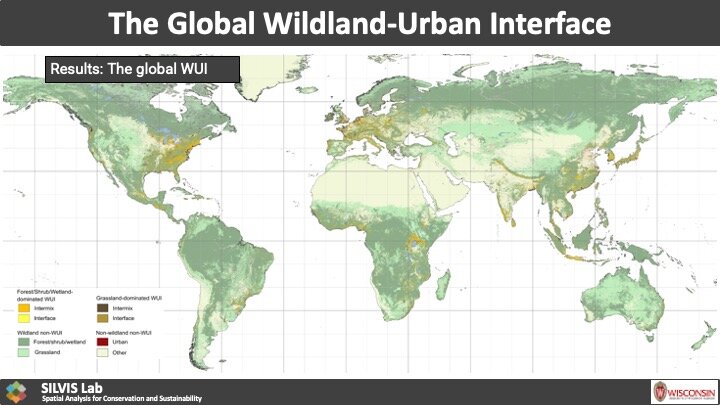A team at the University of Wisconsin–Madison, led by researchers, has developed a groundbreaking tool that maps and visualizes the intersection of human settlements and natural areas on a global scale. This tool, featured in a recent study published in Nature, has the potential to enhance responses to environmental conflicts, including wildfires, the spread of zoonotic diseases, and the loss of ecosystem biodiversity.
These areas, commonly known as the wildland-urban interface (WUI), refer to regions where human habitation and wilderness coexist. Specifically, a WUI is defined as an area with a minimum of one house per 40 acres of land that is also covered by wildland vegetation such as trees, shrubland, grassland, herbaceous wetland, mangroves, moss, and lichen.
Franz Schug, a postdoctoral researcher in the Department of Forest and Wildlife Ecology at UW–Madison, explains that the concept of WUI was originally developed by the U.S. Forest Service to aid in wildfire management in the Western United States.
Although WUIs cover only about 4.7% of the Earth’s land area, approximately half of the global population resides within these regions. Many individuals choose to live in these areas due to their proximity to natural amenities, reflecting a positive affinity for nature. However, WUIs are also hotspots for environmental conflicts such as wildfires, the transmission of diseases from animals, habitat fragmentation, and biodiversity loss. Projected climate change and population growth further escalate the frequency of human-wildland interactions, making it crucial to identify these areas worldwide for future planning purposes.
Despite the significance of WUIs, comprehensive research on their global distribution has been limited to the United States and a few other developed nations. Recognizing this gap, Schug and his team embarked on a mission to investigate the worldwide distribution of WUIs. This endeavor, however, required meticulous data analysis and interpretation, as well as extensive server infrastructure.
After several months of processing enormous amounts of data, the team successfully identified WUIs in previously uncharted regions of Eastern Asia, East Africa, and parts of South America. It is important to note that WUIs exhibit diverse characteristics and ecosystems worldwide, necessitating a contextual understanding for effective management strategies. Schug emphasizes the future interest of WUIs in biomes prone to climate change impacts and areas with significant human populations.
The global WUI map is already being utilized by countries like Poland, Argentina, and Portugal. The comprehensive view it provides serves as a valuable tool for land managers around the world, enabling them to monitor and respond to future challenges arising from climate change, increased wildfires, and heightened interactions between people and wildlife.
For those interested in exploring the global distribution of wildlife-urban interfaces, the team has developed an interactive tool that can be accessed online.
More information:
Franz Schug et al, The global wildland–urban interface, Nature (2023). DOI: 10.1038/s41586-023-06320-0
Citation:
Picturing where wildlands and people meet at a global scale (2023, July 19)
retrieved 19 July 2023
from https://phys.org/news/2023-07-picturing-wildlands-people-global-scale.html
This document is subject to copyright. Apart from any fair dealing for the purpose of private study or research, no
part may be reproduced without written permission. The content is provided for information purposes only.
Denial of responsibility! TechCodex is an automatic aggregator of the all world’s media. In each content, the hyperlink to the primary source is specified. All trademarks belong to their rightful owners, and all materials to their authors. For any complaint, please reach us at – [email protected]. We will take necessary action within 24 hours.

Jessica Irvine is a tech enthusiast specializing in gadgets. From smart home devices to cutting-edge electronics, Jessica explores the world of consumer tech, offering readers comprehensive reviews, hands-on experiences, and expert insights into the coolest and most innovative gadgets on the market.


